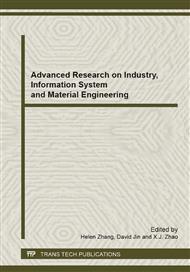[1]
SUITO Hideaki, et al. Thermodynamics on Control of Inclusions Composition in Ultra-clean Steels. ISIJ International, 1996, 36 (5): 528-536.
DOI: 10.2355/isijinternational.36.528
Google Scholar
[2]
NISHIMORI H, et al. Bull. Jpn. Inst. Met., 1993, 1: 441.
Google Scholar
[3]
HOJO Masatake, et al. Oxide Inclusion Control in Ladle and Tundish for Producing Clean Stainless Steel. ISIJ International, 1996, 36(Supplement): S128-S131.
DOI: 10.2355/isijinternational.36.suppl_s128
Google Scholar
[4]
KIM Jong wan, et al. Formation Mechanism of Ca-Si-Al-Mg-Ti-O Inclusions In Type 304 Stainless Steel. ISIJ International, 1996, 36(Supplement): S140-S143.
DOI: 10.2355/isijinternational.36.suppl_s140
Google Scholar
[5]
JIANG Min, et al. Formation of MgO-Al2O3 inclusions in high strength alloyed structural steel refined by CaO-SiO2-Al2O3-MgO slag. ISIJ International, 2008, 48 (7): 885-890.
DOI: 10.2355/isijinternational.48.885
Google Scholar
[6]
OKUYAMA Goro, et al. Effect of Slag Composition on the Kinetics of Formation of Al2O3–MgO Inclusions in Aluminum.
Google Scholar
[7]
HOLAPPA L E K, et al. Inclusion Control in High-Performance Steels. Journal of Materials Processing Technology, 1995, 53: 177-186.
DOI: 10.1016/0924-0136(95)01974-j
Google Scholar
[8]
HIGUCHI Yoshihiko, et al. Inclusion Modification by Calcium Treatment. ISIJ International, 1996, 36 (Supplement): S151-S154.
DOI: 10.2355/isijinternational.36.suppl_s151
Google Scholar
[9]
KUSANO Yoshiaki, et al. Calcium Treatment Technologies for Special Steel Bars and Wire Rods. ISIJ International, 1996, 36 (Supplement): S77-S80.
DOI: 10.2355/isijinternational.36.suppl_s77
Google Scholar
[10]
YE Guozhu, et al. Thermodynamics and Kinetics of the Modification of Al2O3 Inclusions. ISIJ International, 1996, 36 (Supplement): S105-S108.
DOI: 10.2355/isijinternational.36.suppl_s105
Google Scholar
[11]
Murakami Y, Nomoto T, Ueda T. Factors influencing the mechanism of superlong fatigue failure in steels [J]. Fatigue & Fracture of Engineering Materials & Structures, 1999, 22(7): 581-590.
DOI: 10.1046/j.1460-2695.1999.00187.x
Google Scholar
[12]
Murakami Y, Nomoto T, Ueda T, et al. On the mechanism of fatigue failure in the superlong life regime [J]. Fatigue & Fracture of Engineering Materials & Structures, 2000, 23(11): 893-910.
DOI: 10.1046/j.1460-2695.2000.00343.x
Google Scholar
[13]
Murakami Y, Yokoyama N, Nagata J. Mechanism of fatigue failure in ultra-long life regime [J]. Fatigue & Fracture of Engineering Materials & Structures, 2002, 25(8): 735-746.
DOI: 10.1046/j.1460-2695.2002.00576.x
Google Scholar
[14]
Murakami Y, Matsunaga H. Effect of hydrogen on high cycle fatigue properties of stainless steels and other steels used for fuel cell system [C]. Proceedings of the Third International Conference on Very High Cycle Fatigue, Kyoto, 2004: 322-333.
DOI: 10.1016/j.ijfatigue.2005.06.059
Google Scholar


